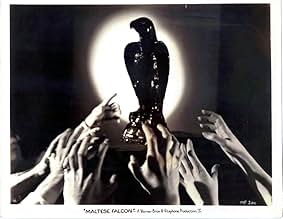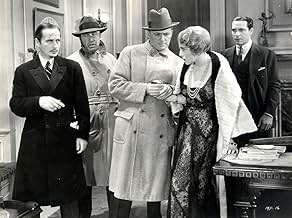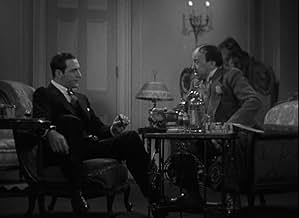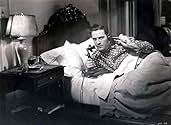Aggiungi una trama nella tua linguaA lovely dame with dangerous lies employs the services of a private detective, who is quickly caught up in the mystery and intrigue of a statuette known as the Maltese Falcon.A lovely dame with dangerous lies employs the services of a private detective, who is quickly caught up in the mystery and intrigue of a statuette known as the Maltese Falcon.A lovely dame with dangerous lies employs the services of a private detective, who is quickly caught up in the mystery and intrigue of a statuette known as the Maltese Falcon.
- Regia
- Sceneggiatura
- Star
- Premi
- 2 vittorie totali
- Capt. John Jacobi
- (non citato nei titoli originali)
- Jailbird Seeking Cigarette
- (non citato nei titoli originali)
- Baggage Clerk
- (non citato nei titoli originali)
- District Attorney
- (non citato nei titoli originali)
- Sarah - Prison Matron
- (non citato nei titoli originali)
Recensioni in evidenza
As in "Satan Met a Lady", the detective is made out to be a sleazy ladies' man in this movie. When we first see him, he's kissing a woman goodbye; we never actually see her face, but we see her adjusting her stocking, and when Sam returns to his office, the pillows from his couch are in disarray. He seems to be getting some from Effie as well (and I must point out that Una Merkel, as Effie, is hot, hot, hot in this movie; quite a contrast to the matronly Lee Patrick in the 1941 version).
Overall, though, this movie is still somewhat unsatisfying. I suppose if we had never seen the Bogart/Huston version, this would stand as an acceptable adaptation of Hammett's novel (by the standards of the time). It follows the novel fairly closely, but skimps on the plot somewhat. The subplot where Wonderley disappears, and then reappears (as O'Shaughnessy) because she realizes Gutman is in town is missing, as is all the great interplay between Spade and Wilmer ("Just keep riding me, buster", "This'll put you in solid with your boss", etc.) that was such a treat in the later version. True, this movie is a little more explicit about the relationship between Gutman and Wilmer, but Wilmer is such a minor character (with literally only a few minutes of screen time) that their relationship still seems more fully-developed in the 1941 movie. There's also a very odd change at the end (just before the prison scene) that seems like something of a cop-out.
And, finally, it must be pointed out that Ricardo Cortez really stinks in this movie. He spends most of the movie with a smirk plastered on his face, and his performance in general is extremely stiff. I suppose that's to be expected in such an early talkie, but, combined with the general aura of sleaziness that his character exudes, it makes it impossible to really care what happens to him. In the end, this is an enjoyable movie, but mainly for reasons of historical curiosity, and it never comes anywhere near the "classic" status that the later remake has achieved.
I found this version slow going, mainly because it's an early talkie - the dialogue pacing isn't quite right. You can drive a truck through the pauses. The only one with a more modern feel for the dialogue is the handsome, smiling Cortez, and he's absolutely marvelous as Spade. His Spade is more relaxed than Bogie's, less sardonic, more delightfully crooked - in short, he has a lot more fun. He fits just as well into this version as world-weary Bogie does into the 1941 version.
Bebe Daniels is attractive and alluring as the greedy and totally ruthless Miss Wonderly. The gay subplot between Greenstreet and Lorre everyone assumes isn't as apparent in this film between Wilmer (Dwight Frye) and Caspar Guttman (Dudley Digges).
I found the comments in the first post on the actors' approaches to their roles very interesting; I'm not sure I totally agree, but for sure, Cortez spoke louder and Daniels did underplay (which she did not do in "42nd Street" - at all). However, as far as the pace, I still Cortez did better in keeping the dialogue going than anyone else.
This is a fascinating film - so different from the 1941 version, which I hope to see this evening - it's definitely worth catching.
Starring as Sam Spade and Miss Wonderly (who never becomes Brigid O'Shaughnessey) are Ricardo Cortez and Bebe Daniels, the talkies' first immortal guy/gal team. And joining them is the familiar ensemble of grotesques: As `Dr.' Joel Cairo, Otto Mathiessen; as Casper Gutman, Dudley Digges (who, lacking Sidney Greenstreet's girth, is never called The Fat Man); and as Wilmer the gunsel, gimlet-eyed Dwight Frye, familiar from the Dracula and Frankenstein franchises. And while Huston's cast in each instance has the edge, it's not by much these pioneering hams have a field day.
Huston trusted Hammett enough to preserve more of his astringent dialogue intact, but Dangerous Woman shows surprising fidelity to the book. The subplot about Spade's affair with his slain partner's wife Iva Archer stays prominent, and the merry widow is played by Thelma Todd (herself later to fall victim in one of Hollywood's most notorious unsolved murders). Owing to less prudish times, before the Hayes Office tried to make sex un-American, the scene is kept where Spade, in his quest for a palmed $1000 bill, makes Wonderly strip naked (though left largely off-screen). And in calling Wilmer Gutman's `boyfriend,' Spade makes a mite more explicit their old-queen/rough-trade dynamic.
Roy del Ruth, who directed, was an old newspaper man who came to Hollywood in the silent era, racking up a workmanlike list of credits (in 1949, he would return to San Francisco locales for the unusual noir Red Light). He adds some deft touches, as when, after Spade departs with her bankroll, Wonderly blithely extracts a fat wad of bills from her stocking. Much of what he might be credited for, however, may be inadvertent. Since the novel was published and the movie made on that critical cusp between the Roaring Twenties and Old Man Depression, an authentic period tang asserts itself Daniels' marcelled hair, for instance (not to mention the Vienna-born Cortez' being palmed off as a Latin lover).
The movie deviates from the novel in ending with a scene in the women's house of detention that manages to be simultaneously sassy and poignant. Dangerous Female offers an instructive lesson in how the various versions, with their differing tones and emphases, shed their own light and shadow on a classic American crime novel.
Contrary to the many comments in user reviews, it is not a pre-code movie. The Movie Production Code (aka Hays Code) was instituted in 1930, but largely ignored by the studios. It wasn't enforced until 1934 when Joseph Breen took over as head of the Motion Picture Code. The story of the years 1930 - 1933 films which contained much more explicit material than was technically permitted by the code is well told in the TCM documentary "Forbidden Film".
Of the three versions of The Maltese Falcon, this is, in my opinion, the second best, with Bogart's version being the best. But this version is a close second, with much to recommend it. It is not more faithful to the novel than the 1941 version, but it is much clearer, especially concerning the sexual sub-plots of the film. It was an A movie in it's time, with top stars including Thelma Todd, Una Merkel, and Dwight Frye. If you like the Bogart version you will probably enjoy this antecedent. Film aficionados and lovers of film history should take special note of this gem.
Una Merkel was superb as the devoted secretary of Sam Spade. She constantly gives off the aura that she has had a physical relationship with him in the past and that some of it still hangs around even though it is essentially over (note their sitting real closely on a chair in one scene, lingeringly holding hands). Thelma Todd plays Archer's wife, who has also had an affair with Sam in the past, and she adds some more spice to the film which is already loaded with it compared to the 1941 version, which was made under the control of the Hollywood Production Code.
The other cast members are wonderful, including Dudley Digges as Casper Gutman, Otto Matieson as Joel Cairo, and Dwight Frye as the psychotic Wilma Cook. They completely hold your attention and are just as interesting, perhaps even more so, than the 1941 version actors.
I am a Bogie fan, but Ricardo Cortez steals the picture with this performance. He is a much more selfish, less noble character than Bogie's Sam Spade, and that makes him more interesting to watch on screen. For instance, in the 1941 version, Bogie's Sam Spade reluctantly gives over the girl to the police because "when your partner is murdered, you are supposed to do something about it." In the 1931 version Ricardo's Sam Spade hands her over simply because he himself doesn't want to be charged with murder. He's saving his own neck, not acting out of some false loyalty to a partner he didn't even like. In fact in this version Ricardo as Sam states firmly, "I couldn't shed a tear for Archer, dead OR alive." This is a lot more honest and realistic.
Don't miss your chance to see this early talkie gem. It is fascinating to watch on its own merits, and also to compare with the later, more famous, Bogart version.
Lo sapevi?
- QuizArt director Robert M. Haas performed the same function on Il mistero del falco (1941).
- BlooperThe same prop is used for the suitcase that Spade finds in Miss Wonderly's room and the suitcase which contains the falcon. The travel stickers are identical on each one.
- Citazioni
Effie Perrine: Sam, it's a gorgeous new customer.
Sam Spade: Gorgeous?
Effie Perrine: A knockout.
Sam Spade: Send her right in, honey.
Effie Perrine: [to the off-screen customer] Will you step in, please?
[Joel Cairo walks in.]
- ConnessioniFeatured in Great Performances: Bacall on Bogart (1988)
I più visti
- How long is The Maltese Falcon?Powered by Alexa
Dettagli
- Data di uscita
- Paese di origine
- Lingue
- Celebre anche come
- The Maltese Falcon
- Luoghi delle riprese
- Azienda produttrice
- Vedi altri crediti dell’azienda su IMDbPro
- Tempo di esecuzione
- 1h 20min(80 min)
- Colore





















